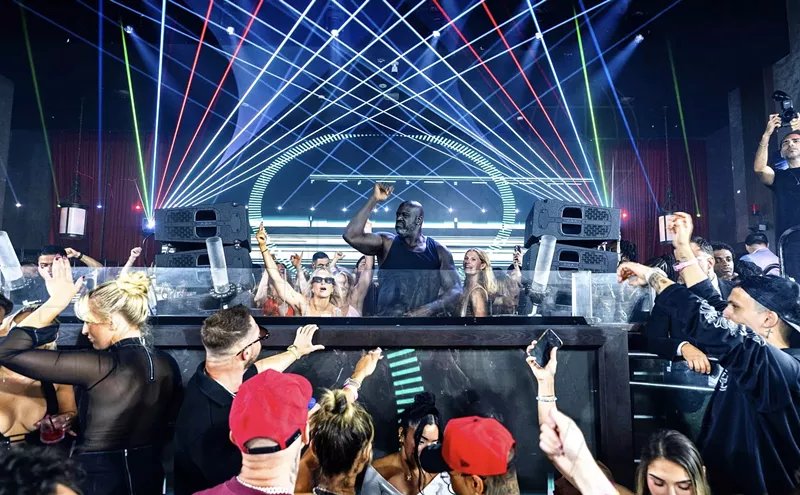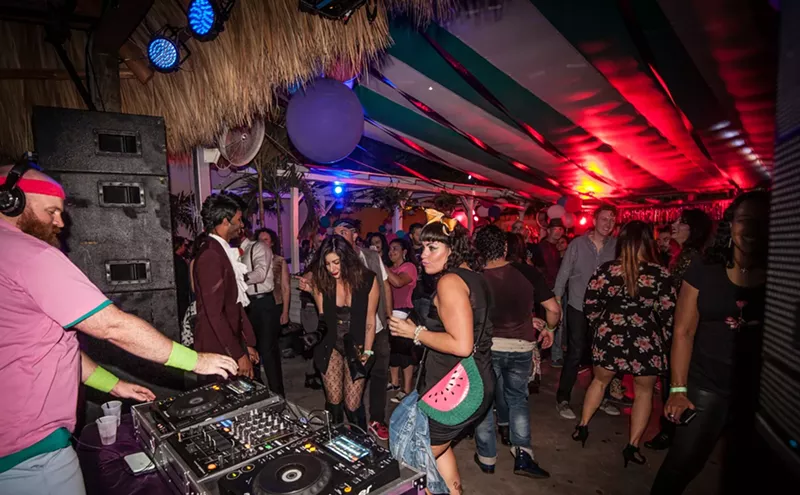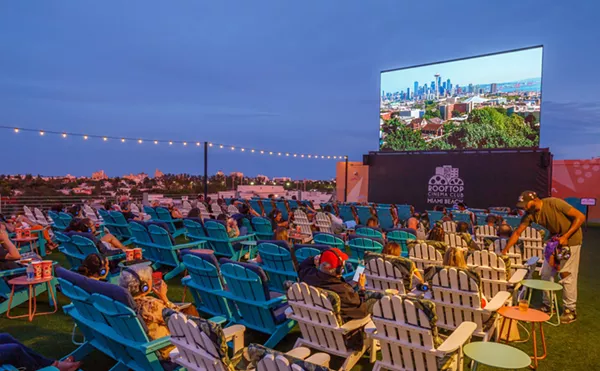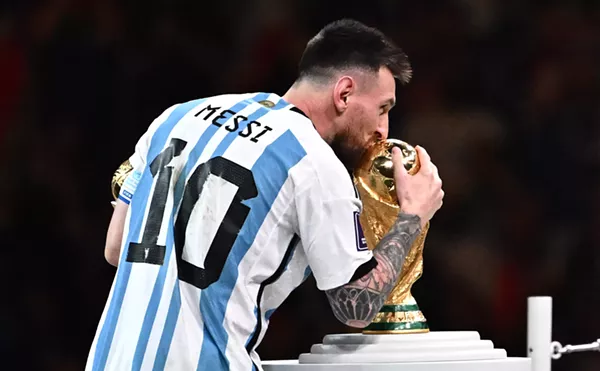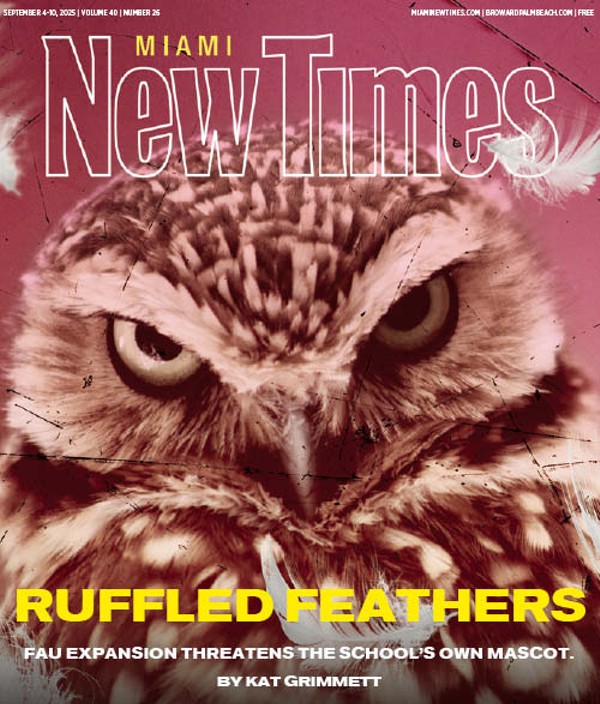It is only 7 p.m., but Robert Fontaine is already beaming. After moving his eponymous gallery to a larger space on NW Second Avenue between 23rd and 24th Streets just in time for this month's Second Saturday Art Walk, the young dealer has already sold $30,000 of work.
He is showing "Collective Memory," a solo exhibit by British artist Nick Gentry that includes portraits painted on floppy discs attached to Masonite. Several collectors ask about other works in Fontaine's pristine, glowing-white gallery.
"When the art's good, it sells itself," Fontaine gushes. "I can celebrate now that the costs of the move have been covered."
Gentry, a tall, handsome, and chestnut-haired chap who bears a striking resemblance to actor Michael C. Hall, smiles confidently through perfect white teeth. Greeting admirers, he is stupefied by the art-walk masses. "The vibrancy here is brilliant," he says. "The way that art and music spills out into the street from the galleries and how people come out to support culture here is astounding. I've never seen anything like this anywhere."
Nearby, large crowds have been lured by a bunch of new openings at established galleries and funky pop-up enterprises that seem to have sprung up out of nowhere. This appears to be the biggest edition of the spring, and thousands of people fill the streets. It's only April, but already the event feels like a rehearsal for December's rambling Art Basel week.
One of these spaces, called the Vinyl Collective (171 NW 23rd St.), is selling old records out of crates and has an area in the back offering artsy jewelry and accessories and silkscreened T-shirts. "Check out my jazz and salsa collection," says Blue Note Records' Bob Perry, who has been invited to set up shop at the place. "I took my name from the famous label with their permission. This is over-the-top like Mardi Gras at Times Square." He claims to have sold close to $600 worth of merchandise.
Across the street, tucked inside a signless, nondescript space on NW 22nd Avenue at First Place, artist Uri Dowbenko displays a sense-numbing collection of loopy abstracts in a show titled "Metaphysical Art." Curious onlookers who peek inside the door are treated to the vision of a man sporting a Day-Glo Mohawk that gives the impression one of Dowbenko's painterly reveries has leeched onto the anonymous mook's head.
On the sidewalk in front of Pan American Art Projects (2450 NW Second Ave.), a group of art squatters commandeers part of the gallery's exterior wall for an ersatz exhibit of photos tacked haphazardly to the building. In front of the guerrilla display, they plant a sign in a strip of grass that reads, "Drop Beats Not Bombs."
In front of the Ascaso Gallery (2441 NW Second Ave.), a band of Uruguayan drummers takes the message to heart and booms a folkloric beat.
Across the street, where Pan American Art Projects hosts an exhibit of Cuban abstract works, gallery director Janda Wetherington rolls her eyes. "These people have positioned themselves under our sign outside as if they are a gallery-sanctioned event," she fumes.
But the real show of the night is in a lot behind Panther Coffee on NW 24th Street, where grill master Raymond Delgado prepares food with military efficiency and waves his arms at a DJ stacking speakers. Behind him are a dozen trucks arranged in a horseshoe arc. The food trucks are the spillover from a lot on NW Second Avenue at 22nd Street that houses another few dozen of the rolling greasy spoons.
Billed as the Wynwood Street Food and Music Festival, the open-air shindig is in full swing after organizers were granted last-minute permits the night before. The event even features a roofed stage housing local acts ranging from Arboles Libres to the Jelly Fish Bothers and Eyelash.
"I will probably end up selling 100 cheesesteak sandwiches for $8 and upwards of 300 churrasco pinchos for $7 by night's end," Delgado crows. "I am building Miami's biggest food truck, that will be 30 feet long and it will have a giant plasma TV recessed into the wall and speakers under the chassis so visitors can catch the Heat games. I am adding blooming onions and lobster bisque soup to my menu. Second Saturday is great for business, and I never run out of food because I have another truck I bring that's refrigerated and I keep packed with extra supplies." Indeed, when I later check with the grill master, Delgado boasts "$2,900 in receipts."
I strike up a conversation with Akim Qhi, a 30-year-old muralist and chef visiting from Barcelona who has never experienced Wynwood's art walk. He gets all Old Master. "I would say that Goya's epoch faithfully reflects the passing of the hours during tonight's Second Saturday," Qhi says. "Initially, everything has the appearance of a royal court, with the people in their finery standing at their doors. Then, as the hours pass and a grand banquet of food and spirits is consumed, the culture of reason is subsumed until that hour of night arrives — a darker moment that ends with Saturn devouring his own children."
I decide this guy has the gloomy soul of an art critic and bring him along to the Lelia Mordoch Galerie (2300 N. Miami Ave.) to catch Didier Gicquel's "1010 Portraits," featuring the Parisian lensman's large black-and-white gelatin silver prints of film, art, music, and literary luminaries captured while visiting the City of Lights over the past three decades. As we stand in front of a picture of Chilean surrealist Roberto Matta, an artist named Daniel Fiorda, who works at the gallery, comes over to share a tale.
"Gicquel told me that when he took this picture, Matta had been preparing for a big solo at a gallery in New York. But when the dealer hosted Matta at his home, the artist screwed his wife while he was at the gallery organizing the exhibit. And when he returned and discovered them together, he canceled the show."
Afterward, we head to Primary Projects (4141 NE Second Ave.), where Lawrence Gipe's "In the Valle de los Caidos" offers the conceptual artist and University of Arizona professor's take on the controversy surrounding the pharaonic tomb at an enormous cathedral that Generalissimo Francisco Franco had built for himself in the Sierra de Guadarrama near Madrid, using prisoners of war as slave labor.
Qhi is impressed by how the artist deftly captured recent Spanish history and how his homeland seems doomed to be split into separate camps. "It made me proud to see Gipe's video of how that cross atop the monument — which is the largest cross in the world — exploded before my eyes," he says.
"If only it could be true and the results leave an empty hole in that valley to plant moreras and that the tombs would blossom in violet, the color of patriots. But it's too late. All the artists, thinkers, and activists who tried to revolutionize that country are long dead and buried in the past, and their contemporaries live in a different land today."




